
Photo for representation only. — Thinkstock.
Boston
Bacteria can act as tiny microbial grenades, bursting and launching microorganisms, including potential pathogens, out of the water and into the air, a study has found.
The study, published in the journal Physical Review Letters, found that bacteria can affect a bubble's longevity.
A bacteria-covered bubble floating at the water's surface can last more than 10 times longer than an uncontaminated one can, persisting for minutes instead of seconds, said researchers from Massachusetts Institute of Technology (MIT) in the US.
During this time, the cap of the contaminated bubble thins.
The thinner the bubble, the higher the number of droplets it can launch into the air when the bubble inevitably bursts.
A single droplet, the researchers estimate, can carry up to thousands of microorganisms, and each bubble can emit hundreds of droplets.
"We discovered bacteria can manipulate interfaces in a manner that can enhance their own water-to-air dispersal," said Lydia Bourouiba, an assistant professor at MIT.
Bourouiba has spent the past several years meticulously generating, imaging, and characterising clean, uncontaminated bubbles, with the goal of establishing a baseline of normal bubble behaviour.
"We first had to understand the physics of clean bubbles before we could add organisms like bacteria to see what effect they have on the system," said Bourouiba.
To directly study bacteria's effect on bubbles, the team set up an experiment in which they filled a column with a solution of water and various bacteria species, including E. coli.
The researchers developed a system to generate bubbles with an air pump, one at a time, inside the column, in order to control the volume and size of each bubble.
When a bubble rose to the surface, the team used high-speed imaging coupled with a range of optical techniques to capture its behaviour, at the surface and as it burst.
The researchers observed that, once a bubble contaminated with E coli made it to the water's surface, its own surface, or cap, immediately started to thin, mostly by draining back into the water, like a melting shell of chocolate. — PTI



























